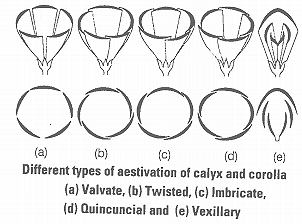The mode of arrangement of petals or sepals in a flower bud with respect to the members of the same whorl or with each other is known asaestivation. It is of following types
Vaivate Margin of adjacent petals or sepals touch each other, but do not overlap, e.g., mustard (Brassica).
Twisted Regular overlapping of petals or sepals occurs in which margin of one petal overlap with the adjacent next onepetal, e.g., China rose (Hibiscus rosa sinensis).
Imbricate There are five petals arranged in such a way that one petal is completely external and one petal is completely internal, three petals are partially external and partially internal, e.g., Cassia, Callistemon, Caesalpinia.
Quincuncial There are five sepals or petals of which two are completely out and two are completely inside, while oneis partially out and partially in e.g., Cucurbita (Cucurbitaceae).
Vexillary It is the characteristic aestivation of corolla of family - Papilionaceae, in which corolla (petals) are papilionaceous.
The largest petal overlap the two lateral petals (wings), whichin turn overlap the two smallest anterior petals (keel) e.g., Artobotrys, Polyalthea, Pisum.

